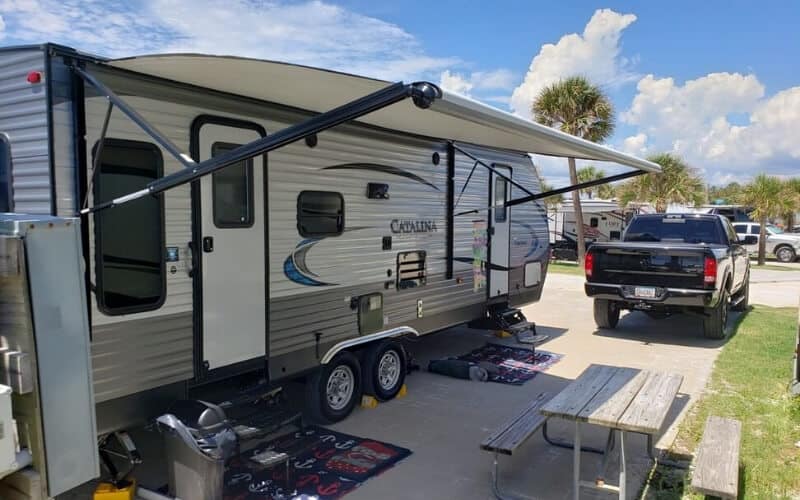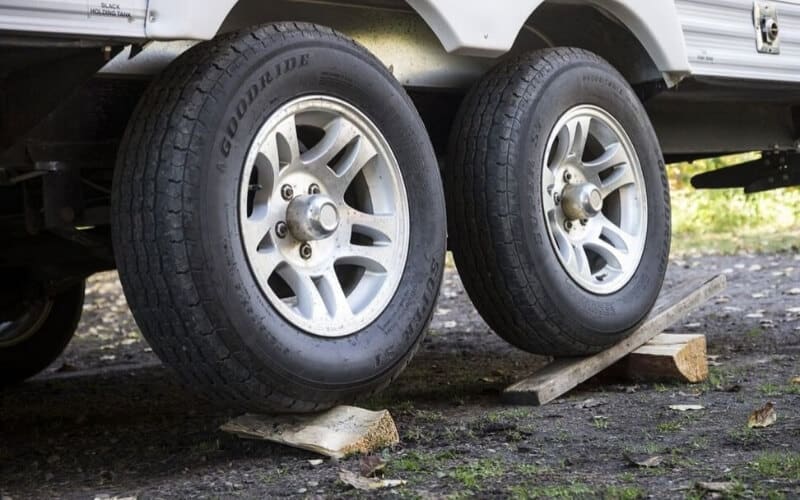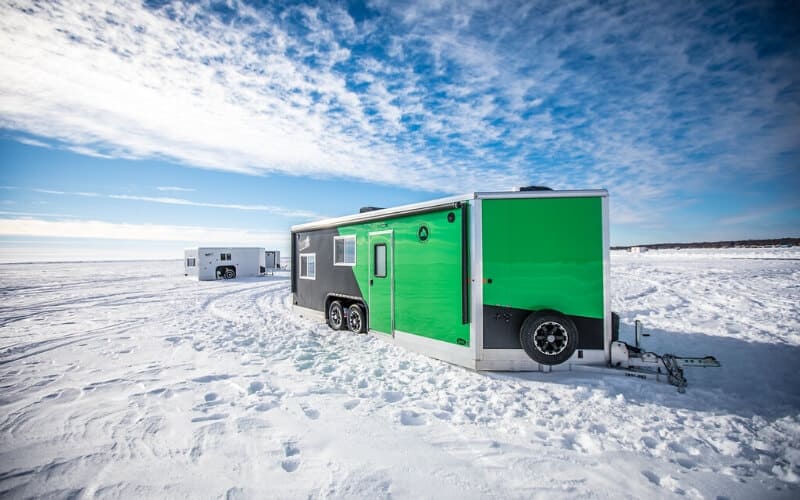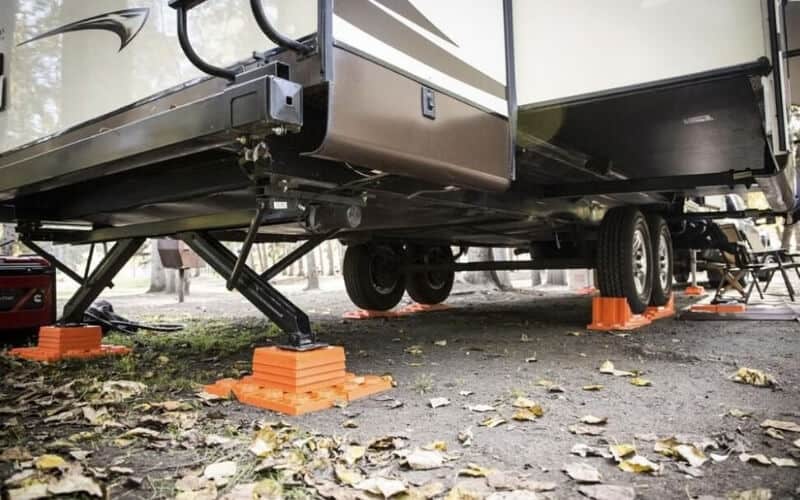These days RV parks and campgrounds are gearing themselves to attract RV travelers who want to establish a permanent home base in a prime area surrounded by attractions.
It’s an especially popular trend for productive fishing lakes, as well as short-term winter retirement villages.
If you will be parking your travel trailer at a campsite, or RV park for the summer or perhaps indefinitely, you will want to get it right the first time.
One of the most important parts of permanently parking a travel trailer is leveling it.
Even the slightest tilt can have annoying consequences like a toilet and sink with inefficient water flow, or just a plain poor night’s sleep.
This might leave you wondering what’s the best way to properly level a travel trailer? The good news is, once you are yourself with a basic understanding of some key principles, it’s not that hard to properly level a travel trailer on a permanent site.
In this article, we will take a closer look at the different ways to level a travel trailer the right way.
This includes understanding the key principles involved in the process, as well as little things you can do to improve your chances of leveling your travel trailer correctly on the first try.

Why Do I Need To Level My Travel Trailer On A Permanent Site?
Right off the bat, a properly level travel trailer lends itself to better sleep quality. Even the slightest tilt from head to foot of the bed can lead to problems like late-night heartburn, sinus congestion, sore muscles, and a stiff back.
If the leveling problem is tilted from left to right it could even increase your chances of accidentally rolling out of bed at night or rolling into the bedside table.
In the case of a significant leveling problem, you might even end up with problems in your water system. Most flushing travel trailer toilets are designed to flush properly when level.
If your travel trailer is too steep of an angle the toilet might only partially flush or not fill the reservoir tank fully.
Sinks in the bathroom and kitchen can also have trouble draining, and material could be left in the drain lines which can further lead to very stubborn clogs.
Depending on the severity of the problem you might also have problems with your storage tanks.
Every degree that your travel trailer is off from the true level, is essentially robbing you of access to freshwater.
You might not notice it at first when the tank is full. Yet, when you get to the end the remaining water may settle away from the water pump and water delivery lines.
A similar effect can happen in your gray water and black water waste storage tanks. An unlevel tank can give you a false indicator reading of being more or less full than it truly is.

This essentially robs you of storage capacity, increases the number of trips you will have to take to the RV dump site with your portable wastewater storage tank, and can even lead to stubborn clogs in your system.
In the kitchen, and unlevel travel trailer can go from being something annoying to the cause of a serious accident.
Sure, things rolling out of a cupboard, and inconsistent pancakes might seem like the sort of thing you can live with for a while.
Yet a pan full of bacon grease that slides off a range top when you step away for a moment can be a serious catastrophe for your travel trailer’s flooring!
Appliances can also suffer from an unlevel travel trailer. If you have a traditional refrigerator in your travel trailer’s kitchen, improper leveling can affect the freon cooling system.
Not only can this affect the performance in the short-term, but it can also shorten your travel trailer refrigerator’s lifespan.
All these seemingly minor headaches and possible safety problems can start to add up over the course of a single vacation.
In time, you might even find yourself not wanting to go to your permanent RV site as much, which is the money going down the proverbial drain in lot rental fees.
Are Permanent Travel Trailer Spots Level?
Unless you are renting a permanent campsite at an RV park with a professionally installed concrete slab, chances are you will have a hard time finding a perfectly level spot to park your travel trailer in the long term.
If you are going to be permanently keeping your travel trailer off the grid on a piece of raw land or at a long-term summer campground, you need to expect to deal with leveling issues right out of the gate.
Tips For Picking A Level Spot To Permanently Park Your Travel Trailer
A discerning eye is a helpful tool when it comes to picking a permanent spot to park your travel trailer. Though some other pieces of equipment can help.
If you are going to be renting a slip at an RV park for the summer or an indefinite stay, you might want to invest in a long concrete level.
There are even some tool and equipment rental agencies that can let you take one for a week for cheap.
This will at least give you a little bit of a gauge on how much adjusting you will need to do when it does finally come time to park up for the long term.

If you are going to be parking your travel trailer on a piece of raw land like a remote job site, or a piece of seasonal hunting land, you’ll need to take the terrain into account.
At first glance, you should be able to spot a significant slope. You might even be able to eye-ball a decently level looking area that offers a little bit of a view.
Here again, the concrete level will help you tease out the details of what kind of leveling challenge you might be facing.
Still, when you are dealing with leveling a travel trailer on raw land, you also want to take into account the firmness of the underlying soil.
What might seem firm, solid and level on a dry day in June, could turn into a soggy, uneven mess during a rainy spell in July.
If possible, you should give preference to an area with a firm or even rocky soil, over sandy, mossy, or boggy terrain.
Clearing The Area
Right off the bat, an RV park rental slip should be perfectly clean, to begin with. Still, you should avoid the temptation to take that barbecue grill out and set it up before backing the travel trailer into place. The fewer obstacles the better.
When you’re dealing with a rustic campsite, you might want to take the time to clear away any stray fallen sticks and tree branches.
Even something like a bunch of acorns can interfere with the leveling process in minute ways that will annoy you later on.
If you are going to be parking your travel trailer on raw land, you will need to take things to the next level.
Ideally, you want to clear the area down to the grass and soil. While you are at it take into account how you will be backing the trailer into place to clear a path.
You might also want to look overhead for any tree branches that need to be trimmed in advance.
The last thing you want to do is park your new travel trailer only to have a widowmaker branch come plunging through the roof.
A Special Tip For Preparing An Ice Fishing Site
There are some parts of the United States and Canada where ice fishing is very popular.
Many anglers will buy “Fish House” campers or ice castle travel trailers to park on a particular hot spot from December through to the middle of March.
If this sounds like your idea of heaven in the winter, then you need to take extra steps to level the area.
While ice itself might seem smooth, there are a lot of things that can alter the surface. Ideally, you want to park your ice castle travel trailer on virgin ice that hasn’t been fished before.

Even if you need to “Pop a few test holes” you still want to shovel away all the slush before it freezes.
If you or someone in your group has access to a plow, you want to clear away the snow all the way down to the underlying ice.
When also factor in where you are going to place your leveling jacks and tires. Something as simple as putting down a handy panel of plywood will keep your tires and jacks from freezing into the ice over the weather changes of winter.
How to Level a Travel Trailer on a Permanent Site
Step 1: Choose and Prepare Your Site
Find the most level site and clear it from all potential obstacles or things that could affect the leveling process.
Step 2: Check Your Travel Trailer With A Level
Chances are your travel trailer on its own isn’t perfectly level. Understanding its characteristics might help you when choosing the orientation of parking it nose-in or nose-out.
Step 3: Place Leveling Blocks Near Your Travel Trailer’s Tires
These lego-like blocks are sold in most large retail hardware stores. They are designed to be very sturdy.
When properly assembled they essentially create a miniature ramp for each of the trailer’s tires. You want to place them at the front of the tires on the side that needs to be adjusted.

If you are going to be parking your travel trailer camper somewhere for a single summer, you might be able to improvise with some pressure-treated lumber.
Still, if you are going to leave your travel trailer for more than say three months, or you aren’t parking on concrete, then you truly do need to invest in proper leveling blocks.
In the long-term wood is prone to water absorption, splitting, and rot, which will alter the level of the travel trailer and be very hard to deal with later on down the road.
Step 4: Carefully Drive The Travel Trailer Onto The Leveling blocks
This is exactly the sort of thing where you want at least one or two more pairs of eyes to help guide you.
You will also want to put your best wheel man in charge. Make sure the people guiding you are familiar with hand signals that they need to be conscious of your mirrors.
Take it slow and do your best not to overcorrect while backing up. You want the tires to be perfectly within the width of your leveling blocks. If they are over by even a little bit, you need to readjust and try again.
Leaving the tire tread overhanging for even a few months can damage the tire. It might survive a summer at the family campsite only to blow up on you when you’re driving it home on a traffic-soaked Labor day weekend.
Step 5: Firmly Place Wheel Chocks Around The Tires To Hold The Travel Trailer In Place
Here again, you can purchase a quality pair of wheel chocks at most hardware stores. If you are just parking up at a seasonal site for the summer, or a base camp for fall hunting trips, you might be able to get away with wood for a few months.
Otherwise, you want the professionally manufactured chocks. If you are frequently going to be away from your travel trailer, and safety is a concern, you might want to invest in locking chocks or taking steps to lock your chocks in place.
You want to make sure the chock is firmly snugged into place toward the unlevel side of the equation. Still chocking both sides of a tire is still a good idea.
Step 6: Slowly Start Lowering The Tongue Jack
Laying down a piece of pressure-treated lumber or a large paving stone in advance of lower the tongue will help give it a solid footing and prevent the jack from sinking into the underlying soil over time.
Place a level near the center of the travel trailer or at the threshold of the door. Carefully watch the bubble or have someone else keep an eye on it while you slowly crank the tongue down.
Step 7: Install Any Stabilizing Jacks
Many people who park their travel trailer permanently or seasonally will use stabilizing jacks at the four corners of their camper.
Some travel trailers come with them, some manufacturers offer them as extras. If you don’t have any stabilizing jacks, you might want to invest in some jack stands in the automotive section.
They are designed to prevent the travel trailer from rocking or shimmying side to side. You’ll also get fewer squeaks when you move around, and the tongue jack won’t have to bear so much long-term strain.
In Conclusion
Years ago, the idea of an unlevel trailer was something you just needlessly lived with. Yet, over the years more and more RV travelers have taken to new standards to both preserve their valuable investment in a travel trailer, as well as give them more of the comforts of home.
It helps to have everything you need with you including an accurate level, leveling blocks, wheel chocks, and stabilizing jacks.
Once you choose and prepare your site, these steps will help ensure an easy process for leveling your travel trailer permanently or for the season.







1 Comment
Gary
1 year agoThis leveling procedure seems the same as an overnite procedure. If permanent, wouldn’t you want to take the load off the wheels?